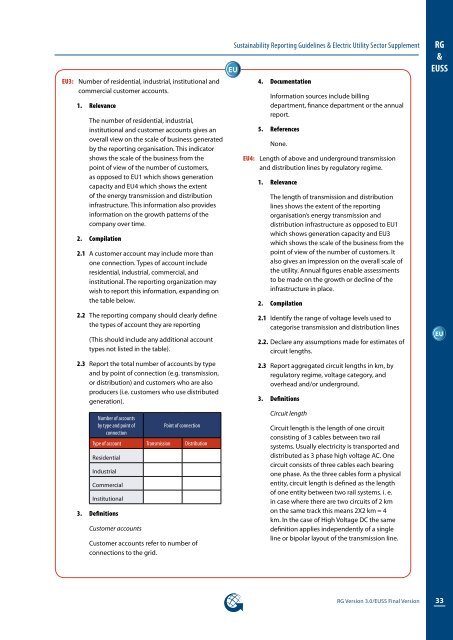Electric Utilities Sector Supplement - Global Reporting Initiative
Electric Utilities Sector Supplement - Global Reporting Initiative
Electric Utilities Sector Supplement - Global Reporting Initiative
You also want an ePaper? Increase the reach of your titles
YUMPU automatically turns print PDFs into web optimized ePapers that Google loves.
EU3:<br />
Number of residential, industrial, institutional and<br />
commercial customer accounts.<br />
1. Relevance<br />
The number of residential, industrial,<br />
institutional and customer accounts gives an<br />
overall view on the scale of business generated<br />
by the reporting organisation. This indicator<br />
shows the scale of the business from the<br />
point of view of the number of customers,<br />
as opposed to EU1 which shows generation<br />
capacity and EU4 which shows the extent<br />
of the energy transmission and distribution<br />
infrastructure. This information also provides<br />
information on the growth patterns of the<br />
company over time.<br />
2. Compilation<br />
2.1 A customer account may include more than<br />
one connection. Types of account include<br />
residential, industrial, commercial, and<br />
institutional. The reporting organization may<br />
wish to report this information, expanding on<br />
the table below.<br />
EU<br />
Sustainability <strong>Reporting</strong> Guidelines & <strong>Electric</strong> Utility <strong>Sector</strong> <strong>Supplement</strong><br />
EU4:<br />
4. Documentation<br />
Information sources include billing<br />
department, finance department or the annual<br />
report.<br />
5. References<br />
None.<br />
Length of above and underground transmission<br />
and distribution lines by regulatory regime.<br />
1. Relevance<br />
The length of transmission and distribution<br />
lines shows the extent of the reporting<br />
organisation’s energy transmission and<br />
distribution infrastructure as opposed to EU1<br />
which shows generation capacity and EU3<br />
which shows the scale of the business from the<br />
point of view of the number of customers. It<br />
also gives an impression on the overall scale of<br />
the utility. Annual figures enable assessments<br />
to be made on the growth or decline of the<br />
infrastructure in place.<br />
2. Compilation<br />
RG<br />
&<br />
EUSS<br />
2.2 The reporting company should clearly define<br />
the types of account they are reporting<br />
(This should include any additional account<br />
types not listed in the table).<br />
2.1 Identify the range of voltage levels used to<br />
categorise transmission and distribution lines<br />
2.2. Declare any assumptions made for estimates of<br />
circuit lengths.<br />
EU<br />
2.3 Report the total number of accounts by type<br />
and by point of connection (e.g. transmission,<br />
or distribution) and customers who are also<br />
producers (i.e. customers who use distributed<br />
generation).<br />
2.3 Report aggregated circuit lengths in km, by<br />
regulatory regime, voltage category, and<br />
overhead and/or underground.<br />
3. Definitions<br />
Number of accounts<br />
by type and point of<br />
Point of connection<br />
connection<br />
Type of account Transmission Distribution<br />
Residential<br />
Industrial<br />
Commercial<br />
Institutional<br />
3. Definitions<br />
Customer accounts<br />
Customer accounts refer to number of<br />
connections to the grid.<br />
Circuit length<br />
Circuit length is the length of one circuit<br />
consisting of 3 cables between two rail<br />
systems. Usually electricity is transported and<br />
distributed as 3 phase high voltage AC. One<br />
circuit consists of three cables each bearing<br />
one phase. As the three cables form a physical<br />
entity, circuit length is defined as the length<br />
of one entity between two rail systems. i. e.<br />
in case where there are two circuits of 2 km<br />
on the same track this means 2X2 km = 4<br />
km. In the case of High Voltage DC the same<br />
definition applies independently of a single<br />
line or bipolar layout of the transmission line.<br />
RG Version 3.0/EUSS Final Version<br />
33

















